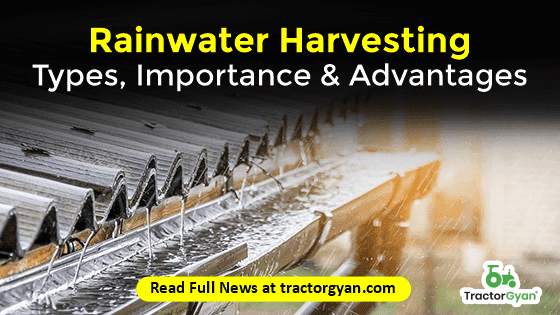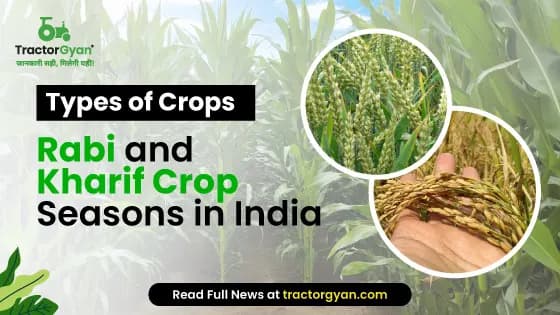Rainwater Harvesting - Types, Importance & Advantages
Table of Content
India, being an agricultural-oriented country, requires water at every step of the harvest and farming process. Hence, saving water is undoubtedly crucial to rainwater harvesting, making it easier for farmers to save and store rainwater.
Given the current situation in regard to water conservation, which is poor, and water as a resource getting scarce due to various factors, saving water becomes important. There are various ways in which water can be saved, and the most famous and easy one is Rainwater harvesting.
What is Rainwater Harvesting?

The rainwater Harvesting system is one of the most effortless processes for saving and storing rainwater for future use. Rainwater harvesting helps a lot in areas with ample rainfall throughout the year and during the monsoon season. By utilising this natural resource, we can reduce groundwater consumption for daily activities, helping us conserve it in times of drought.
The Rainwater Harvesting system is not just a simple mechanism; it requires proper knowledge about the technique, its importance, its advantages and disadvantages, and much more so that you can get an idea of what exactly it is. Tractor Gyan is the only place you need in this blog, all the necessary information about Rainwater Harvesting is available.
Techniques of Rainwater Harvesting

There are mainly two types of Rainwater harvesting:
1. Surface Runoff: Surface runoff harvesting is the most common form of rainwater harvesting. It involves collecting the water that runs off the surfaces of roofs, driveways, and other areas and storing it for later use. This water can be used for irrigation, washing, and other purposes.
2. Rooftop Rainwater Harvesting: Rooftop Rainwater Harvesting refers to saving or collecting rainwater from the roof of residential or commercial structures, diverted and stored in tanks. Rooftop Rainwater Harvesting is practised in individual households or schools. The harvested rainwater can be used for day-to-day necessities such as washing dishes, bathing needs, flushing, watering plants, washing machines, and much more.
Importance of Rainwater Harvesting
Rainwater Harvesting System is necessary, especially in the current days when natural resources are getting scarce, poverty is on the rise, and human health is getting depleted. Rainwater Harvesting can solve all these problems and much more, which is why it is an important practice.
The importance of Rainwater Harvesting includes:
1. Water conservation: One of the importance of Rainwater harvesting system is that it helps conserve and replenish water resources. By collecting rainwater, we can reduce the strain on traditional water sources such as rivers, lakes, and underground aquifers. It provides an alternative source of water that can be utilized for different purposes, thereby reducing the demand for freshwater.
2. Mitigating water scarcity: In areas with limited access to freshwater resources, rainwater harvesting system can be a lifeline. It allows individuals, communities, and industries to become less dependent on scarce water sources, particularly during droughts or prolonged dry periods. Rainwater can be used for various non-potable purposes, such as irrigation, cleaning, and livestock watering, thereby reducing the pressure on limited freshwater supplies.
3. Sustainable agriculture: Rainwater harvesting is crucial for agricultural sustainability, particularly in regions where irrigation water is scarce or unaffordable. Collected rainwater can be utilized for crop irrigation, reducing the reliance on groundwater or expensive external sources.
4. Groundwater recharge: Rainwater harvesting system helps replenish groundwater reserves. When rainwater is collected and stored in underground tanks or directed to recharge pits, it percolates into the soil, recharging the groundwater table. This helps maintain the water levels in aquifers, ensuring a sustainable supply of groundwater for domestic, agricultural, and industrial purposes.
5. Reducing soil erosion: Rainwater harvesting can effectively control soil erosion. By collecting rainwater from rooftops and directing it into storage tanks or pits, the force of the falling rain is reduced. This prevents soil erosion caused by the impact of raindrops, protects topsoil, and improves soil fertility. By conserving soil moisture, the rainwater harvesting system also supports plant growth and helps retain the nutrients present in soils.
6. Mitigating floods and localized flooding: In urban areas, excessive rainfall can often lead to floods and localized flooding due to poorly managed stormwater runoff. Rainwater harvesting can help reduce the volume of stormwater runoff by collecting and storing rainwater in decentralized systems such as rooftop collection tanks, ponds, or infiltration pits. This reduces the risk of flooding, alleviates pressure on drainage systems, and helps recharge groundwater.
7. Water quality improvement: Rainwater is generally cleaner and softer than groundwater or surface water sources. When rainwater is collected from clean roofs and stored properly, it can be of high quality and suitable for various non-potable uses such as toilet flushing, laundry, and gardening. By utilizing rainwater for these purposes, we reduce the demand for treated drinking water, which is a valuable resource in itself.
8. Cost-effective water supply: Rainwater harvesting provides a cost-effective solution for meeting water requirements. Once the initial infrastructure is set up, the maintenance costs of rainwater harvesting systems are relatively low compared to the expenses associated with treating and supplying water from alternative sources. Rainwater is free and abundant in many regions, making it an affordable option for both urban and rural communities.
9. Climate change adaptation: With climate change leading to more frequent and intense droughts, floods, and erratic rainfall patterns, rainwater harvesting is an essential adaptation strategy. By capturing and storing rainwater during periods of heavy rainfall, communities can build resilience against water scarcity during dry spells. Rainwater harvesting can act as a buffer, reducing vulnerability and providing a reliable water source when traditional sources are unreliable.
10. Awareness and education: Rainwater harvesting promotes awareness and education about the value of water and the need for sustainable water management. Implementing rainwater harvesting systems at the individual, community, and institutional levels increases knowledge about water conservation, encourages responsible water use, and fosters a greater appreciation for water resources.
Types of Rainwater Harvesting

There are various ways in which Rainwater Harvesting can be practiced, including:
-
Water Butt: Mainly used for watering plants, this is one of the most mainstream types of rainwater harvesting. Under this, the rainwater is collected in a container or drainage pipes.
-
Direct Pump: There are two types of techniques in Direct Pump:
1. Submersible: Submersible pumps are used to pump out the water directly from the collection container or drainage pipes. This is the most efficient way of using rainwater, as it does not require any filtration or storage.
2. Suction: Suction pumps are the most efficient way of using rainwater, as they do not require any filtration or storage. They rely on suction to draw water from the ground or a tank into the home. This method has the added benefit of being able to draw water from a larger area, allowing users to harvest more rainwater. Additionally, this method does not require any additional hardware or infrastructure and is relatively inexpensive to install and maintain.
-
Indirect Pumped: Under this kind of rainwater harvesting, the system does not rely on gravity to supply water; instead, it uses pumps to supply harvested water to a tank that can be located at any level of the building. Additionally, a booster pump is also used to provide a pressurized water supply. The USP of this system is that it provides ample flexibility to customise the booster pump so that it can adjust its pressure as per the building's requirements and capacity.
-
Indirect Gravity: This system used only gravity to supply water by supplying water first to the header tank and then allowing it to flow freely. In Indirect Gravity systems, the pumps are used to only fill the header tank, which is the main body to store the rainwater.
-
Gravity Only: Gravity is the most natural form of rainwater harvesting. It uses purely gravitational sources to supply and store rainwater. In this kind of system, the water can be stored only when the tanks are located below the level of the gutters and above the supplying outlets.
-
Retention Ponds: Retention ponds are man-made bodies of water designed to capture and hold stormwater runoff. These ponds are essential in urban areas where pavement and concrete prevent the natural infiltration of rainwater into the ground. Retention ponds help mitigate the negative impacts of urbanization by providing a solution to manage excess stormwater. They are strategically located to collect runoff from parking lots, rooftops, and other spaces.
-
In-Ground Storage: In-ground sources refer to underground water reserves that can be accessed through wells or underground aquifers. These sources are vital for water supply in many regions, especially in areas where surface water may be limited or contaminated. In-ground sources offer a reliable and sustainable solution for long-term water needs, as they are replenished by natural processes such as precipitation. However, it is crucial to manage and protect these sources carefully to ensure their sustainability. This involves monitoring water levels, controlling extraction rates, and implementing conservation measures to avoid overexploitation.
Advantages of Rainwater Harvesting

Apart from saving and storing water for harvesting purposes, Rainwater Harvesting is beneficial in various other ways. The list of advantages of rainwater harvesting includes:
-
Conserves water: Rainwater Harvesting famously conserves rainwater by using various systems and techniques. This conserved rainwater is saved not only for agricultural uses but can also be used for various other purposes.
-
Saves money: Rainwater Harvesting saves money and reduces bills because the rainwater can be conserved for a long time and used for numerous purposes; hence, not much money is spent on water bills. Additionally, the techniques and systems of rainwater harvesting are easy to operate and require no expensive gear.
-
Reduces the demand for freshwater reserves: Rainwater Harvesting is a great way to decrease the demand for freshwater resources or reserves because all the needs are fulfilled using rainwater, so there is no need to exploit freshwater resources.
-
Slows down soil erosion in dry areas: Rainwater Harvesting helps keep the soil moist and significantly prevents water runoff, resulting in slowing down soil erosion. It also captures a small amount of precipitation as surface runoff.
-
Prevent flooding in low-lying areas: Thanks to Rainwater harvesting, flooding in low-lying areas can be completely prevented. This happens when we conserve rainwater and reduce the flow of stormwater to prevent urban flooding. Numerous buildings that have an active rainwater harvesting system have built-in catchment areas on top of the roof to collect large volumes of rainwater in case of rainstorms.
Where should I go to get more information about Rainwater Harvesting?
Whenever there’s a farming need or query, there is only one name that all the Indian farmers trust and that is Tractor Gyan. Tractor Gyan has been known to cater to all farming-related needs and queries for years by delivering 100 percent authentic information that is updated regularly.
All of the information that is listed on Tractor Gyan’s website is verified by a team of experts before being published on the website. For more farming news and updates, keep visiting Tractor Gyan.
About TractorGyan
Tractor Gyan is an expert-led platform that aims to empower Indian farmers by providing accurate and timely information, and technological advancement about tractors and farm equipment in India.
TractorGyan helps farmers with New Tractor information, Compare Tractors, Tractor prices, Buying and selling of second-hand tractors, Tractor Insurance, Tractor Finance, Tractor tyre, Tractor Implements, Tractor EMI calculator and more.
On our Platform, we have information about leading brands :
-
In tractors like Captain, Preet, Farmtrac, Vst shakti
-
In Tyres like BKT, Ceat, Apollo etc.
-
In Tractor Finance like Mahindra Finance, TVS Finance, Etc.
-
In Tractor Implements like Shaktiman, Fieldking, Landforce, KS agrotech, etc.
-
In Tractor Insurance like Mahindra Finance, Axis Bank, ICICI Bank, etc.
TractorGyan is Helping India mechanise by delivering crucial information about tractor buying and guiding farmers at every step so that they get a tractor or farm equipment that empowers and equips them to produce quality yield.
Category
Read More Blogs
Shifting cultivation is a form of farming method which is practiced by millions of people across the world, especially in south-east Asia. It was first considered environmentally destructive, but now with much research, it has been concluded that shifting cultivation can be...
Apiculture is the technique or farming practice that involves the production of honey, beeswax, royal jelly, flower pollen, and bee pollen. The process is also known as beekeeping. So, Technically Apiculture is bee farming. This process of farming involves the cultivation of...
Welcome to the fascinating world of urban farming! Have you ever wondered how we can bring the joys of farming right into the heart of our bustling cities? Well, urban farming is the answer!
In this blog, we will dive into the captivating...
Write Your Comment About Rainwater Harvesting - Types, Importance & Advantages
.webp&w=1920&q=75)
Top searching blogs about Tractors and Agriculture
30 Jul 2025
30 Jul 2025
29 Jul 2025
08 Sep 2025
03 Jul 2025
30 Jul 2025
30 Jul 2025
30 Jul 2025
29 Jul 2025
30 Jul 2025
29 Sep 2025
31 Jul 2025
30 Jul 2025
31 Jul 2025















.webp&w=3840&q=75)










.webp&w=3840&q=75)
.webp&w=3840&q=75)



























